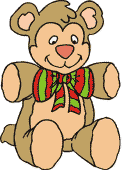
Toys under the Tree
Hand-crafted Christmas presents have a long tradition in Germany
This time of year, Canadian kids may more likely dream of Santa and his elves shifting into high gear in the North Pole workshop than of a White Christmas. In Germany, most little tykes will check the evening skies for hues of pinks and reds sure signs of the angels busy at work helping the Christkind ready the presents for the magic night of December 24.
These were the evenings when, in the old days, children would go to bed early, happily knowing that all was well, giving parents the extra hour or two at night to don their Christmas helpers hats. New dolls’ clothes would be sewn or old ones spruced up; scroll saw and other woodworking tools would come out to fix dollhouses, farmhouses and their carved animals. Building blocks would be cut and painted in bright colours, puppet theatres’ backdrops repaired, the princess fitted with a new chiffon veil and the crocodile with a new, stronger jaw joint.
Today, evening strolls through Germany's hundreds of Christmas markets evoke memories of those days as the eyes feast on the hand-crafted toys and decorations on display. At the end of the night, as the lights dim and carols fade, bulging bags carried home testify to the ongoing love of hand-made gifts.
Children have long received the lion’s share of such artifacts to play with - invent new worlds with replicas of grown-ups’ objects or discover the secrets of science and nature with all manner of blocks and tools fit for little hands and big minds. Before the days of dollhouse building kits, beautifully crafted furniture samplers surely lit up many a four-year-old’s eyes. Model train sets, still delighting today’s pre-schoolers and their parents, helped demystify the 19th-century world of locomotives and railways for those youngsters frightened by steaming iron monsters roaring through their idyllic countryside.
Germany abounds with toy museums, small and large. In the heart of Franconia, (about 170 km north of Munich, 230 km southeast of Frankfurt), Nuremberg is home to one of the country’s more extensive collections, the Spielzeugmuseum - fitting for a town hosting the world’s largest toy fair every year. Celebrating her 950th anniversary this year, Nuremberg once counted tin toy making as one of the city¹s industries. (To this day, elaborately painted and embossed tin boxes are used to ship Nuremberg’s famous gingerbreads around the globe, another of the city¹s traditional exports.)
Because the city marks the intersection of the ancient German salt-trading route and another route coming north over the Alps from Venice, her merchants traded in all kinds of goods, including toys, referred to as Nürnberger Tand (Nuremberg trinkets) in the old days. They were handcrafted wooden toys from Berchtesgaden and Oberammergau, dolls from Thuringia, and from Saxony¹s Ore Mountains the trademark turned, carved and hand-painted toy figurines of which the nutcracker has become the most famous.
Nuremberg’s toy museum opened in 1972 in the Old Town, in a new building erected behind the restored facade of an original Renaissance house. Its increasing collection includes dolls, dollhouses, wooden figurines and tin toys, of course, and as a major attraction for young and old, a 30-square-metre working model train set. It also pays homage to the great German educator Friedrich Froebel, who first promoted building blocks to teaching tools for tots. Born in 1782 in Thuringia, Froebel was a keen observer, in charge of raising the two little sons of his deceased brother. As he watched the boys growing up, he noticed how differently they each explored the world around, learning about life in their individual ways. Fascinated, he developed his educational theories, resulting in the kindergarten (garden of children) and thus further advancing the pedagogic movement we now call child-centred learning.
Another collection of historic and new building block sets is housed in Munich’s Deutsche Museum. The four dedicated rooms display the sets according to their material wood, stone, metal and plastic. The sets range from simple, basic wooden shapes, to elaborate stone palaces and fortresses, metal sets for steam engines to today¹s LEGO blocks and their unlimited creations.
 Antique
teddy bears, dolls, tin soldiers and more attract visitors to the Thuringian
town of Sonneberg (130 km north of Nuremberg) and its Spielzeugmuseum, one
of Germany’s oldest toy museums, celebrating 100 years in 2001 and housing
close to 100,000 objects. It and all of Germany’s many other toy museums
will see their visitor numbers swell in the weeks before Christmas.
Anticipation of good things to come make for a big part of any holiday joy,
and at Christmas it’s only rivalled by the sight of Mom and Dad creating
new worlds alongside their offspring under the brightly-lit tree.
Antique
teddy bears, dolls, tin soldiers and more attract visitors to the Thuringian
town of Sonneberg (130 km north of Nuremberg) and its Spielzeugmuseum, one
of Germany’s oldest toy museums, celebrating 100 years in 2001 and housing
close to 100,000 objects. It and all of Germany’s many other toy museums
will see their visitor numbers swell in the weeks before Christmas.
Anticipation of good things to come make for a big part of any holiday joy,
and at Christmas it’s only rivalled by the sight of Mom and Dad creating
new worlds alongside their offspring under the brightly-lit tree.
